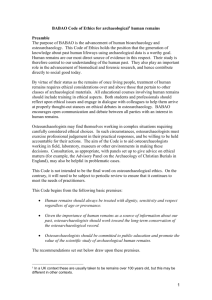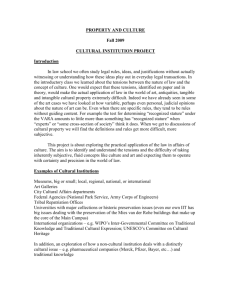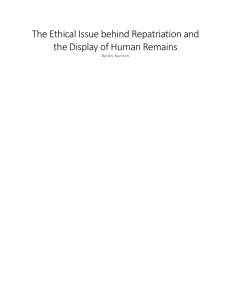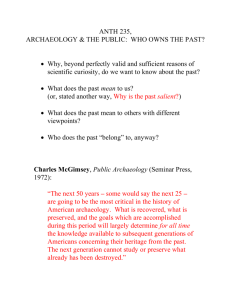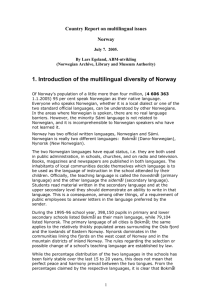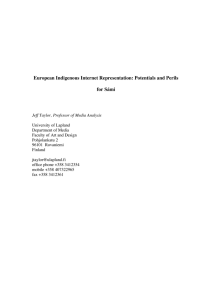Repatriation and Reburial of Human Remains
advertisement
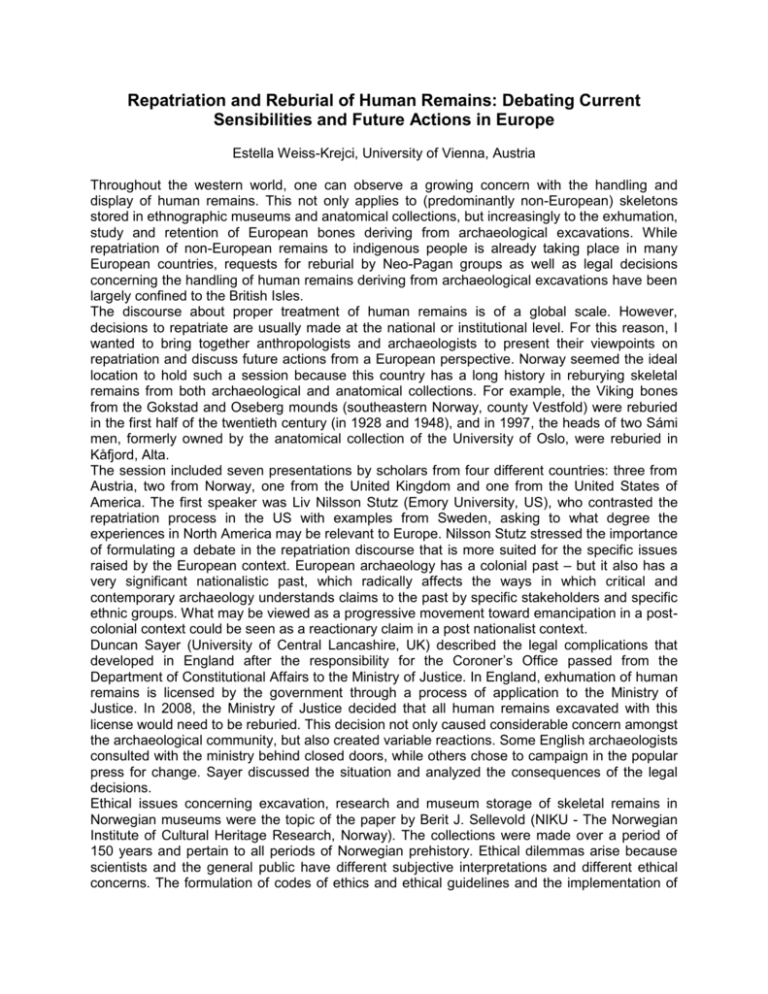
Repatriation and Reburial of Human Remains: Debating Current Sensibilities and Future Actions in Europe Estella Weiss-Krejci, University of Vienna, Austria Throughout the western world, one can observe a growing concern with the handling and display of human remains. This not only applies to (predominantly non-European) skeletons stored in ethnographic museums and anatomical collections, but increasingly to the exhumation, study and retention of European bones deriving from archaeological excavations. While repatriation of non-European remains to indigenous people is already taking place in many European countries, requests for reburial by Neo-Pagan groups as well as legal decisions concerning the handling of human remains deriving from archaeological excavations have been largely confined to the British Isles. The discourse about proper treatment of human remains is of a global scale. However, decisions to repatriate are usually made at the national or institutional level. For this reason, I wanted to bring together anthropologists and archaeologists to present their viewpoints on repatriation and discuss future actions from a European perspective. Norway seemed the ideal location to hold such a session because this country has a long history in reburying skeletal remains from both archaeological and anatomical collections. For example, the Viking bones from the Gokstad and Oseberg mounds (southeastern Norway, county Vestfold) were reburied in the first half of the twentieth century (in 1928 and 1948), and in 1997, the heads of two Sámi men, formerly owned by the anatomical collection of the University of Oslo, were reburied in Kåfjord, Alta. The session included seven presentations by scholars from four different countries: three from Austria, two from Norway, one from the United Kingdom and one from the United States of America. The first speaker was Liv Nilsson Stutz (Emory University, US), who contrasted the repatriation process in the US with examples from Sweden, asking to what degree the experiences in North America may be relevant to Europe. Nilsson Stutz stressed the importance of formulating a debate in the repatriation discourse that is more suited for the specific issues raised by the European context. European archaeology has a colonial past – but it also has a very significant nationalistic past, which radically affects the ways in which critical and contemporary archaeology understands claims to the past by specific stakeholders and specific ethnic groups. What may be viewed as a progressive movement toward emancipation in a postcolonial context could be seen as a reactionary claim in a post nationalist context. Duncan Sayer (University of Central Lancashire, UK) described the legal complications that developed in England after the responsibility for the Coroner’s Office passed from the Department of Constitutional Affairs to the Ministry of Justice. In England, exhumation of human remains is licensed by the government through a process of application to the Ministry of Justice. In 2008, the Ministry of Justice decided that all human remains excavated with this license would need to be reburied. This decision not only caused considerable concern amongst the archaeological community, but also created variable reactions. Some English archaeologists consulted with the ministry behind closed doors, while others chose to campaign in the popular press for change. Sayer discussed the situation and analyzed the consequences of the legal decisions. Ethical issues concerning excavation, research and museum storage of skeletal remains in Norwegian museums were the topic of the paper by Berit J. Sellevold (NIKU - The Norwegian Institute of Cultural Heritage Research, Norway). The collections were made over a period of 150 years and pertain to all periods of Norwegian prehistory. Ethical dilemmas arise because scientists and the general public have different subjective interpretations and different ethical concerns. The formulation of codes of ethics and ethical guidelines and the implementation of practical measures, such as repatriation, have been outcomes of efforts to deal with these ethical dilemmas. However, using a graphic model, Sellevold showed that not all types of bones are perceived in the same way and that the ethics are somehow biased. For example, inhumations are rated higher than cremated bones; remains that can be associated with a name are more likely to be selected for reburial than anonymous bones. The fourth paper, presented by Edeltraud Aspöck (Austrian Academy of Sciences ÖAW, Austria) and coauthored by me, addressed the sanctity of human remains from a historic and cross-cultural perspective. The very general questions around which this paper revolved were: is there a right way of dealing with human remains? What is a proper burial? Whose laws, whose ethics and whose political agenda should one follow when considering repatriation? We approached these questions by looking at a series of misconceptions, which can be found as part of the arguments in today’s repatriation and reburial discussion. For each misconception (e.g. ‘exhumation is unethical’, ‘display is unethical’, etc.), we presented archaeological, historical and ethnographic counter-examples. After the coffee break, we listened to a presentation by Maria Teschler (Natural History Museum Vienna, Austria). As head of the anthropology department in a museum that houses 40 000 human skeletons and skulls, she has been involved in several repatriation events. In particular, collections made between 1907 and 1909 by Rudolf Pöch, an anthropologist, travelling explorer and media pioneer have become subject to scrutiny. Teschler critically reflected on past collection practices and discussed the future handling of these human remains. She also presented her current research project, which is funded by the Austrian Federal Ministry of Science and Research and deals with ethical and scientific aspects of anthropological museum collections. Stine Camilla Bergum (Norwegian Sami Parliament, Norway) presented a summary of the situation of the Norwegian Sámi, whose skeletal remains have been collected since the 1850s. She showed how the attitude of the Sámi changed over time. Some Sámi originally assisted in retrieving skeletons for research. However, the more the focus shifted to the description of racial traits and to the display of the Sámi as an inferior people, the more they started to protest against the acquiring of their remains. The Sámi Parliament was founded in 1989 and the status of the Sámi as indigenous people was ratified by the Norwegian government in 1990. Since then the Sámi parliament has gained full control over the Sámi human remains, which has resulted in restitution and reburial. The last paper was my own contribution on attitudes towards dead bodies in present-day Europe. The paper’s core argument was that a European discussion about repatriation and reburial needed to take into account present-day country- and group-specific cultural attitudes towards our own dead. I outlined some major differences in Europe (highlighting Austria, England and the Netherlands) and tried to identify some of the reasons why the establishment of pan-European ethical codes and legislations regarding human remains may be hard to achieve. The session wrapped up with a 40 minute-long discussion involving some of the speakers and the multi-national audience. We touched upon a series of issues such as the question what ‘care for the dead’ actually implied. I was also criticized by some English archaeologists for overrating the political influence of the British Neo-Pagans. Several people warned against striving for legal decisions because reburial and repatriation laws would only complicate matters. Instead it was suggested that we should engage in a continuous scientific discourse about how to deal with human remains in a multi-cultural world.
